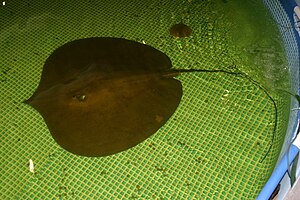Giant freshwater stingrays
| Giant freshwater stingrays | ||||||||||||
|---|---|---|---|---|---|---|---|---|---|---|---|---|

Giant freshwater stingray ( Urogymnus polylepis ) |
||||||||||||
| Systematics | ||||||||||||
|
||||||||||||
| Scientific name | ||||||||||||
| Urogymnus polylepis | ||||||||||||
| ( Bleeker , 1852) |
The giant freshwater stingray ( Urogymnus polylepis ) is a species of fish from the family of stingrays that occurs in the Mae Nam Chao Phraya and Mekong, as well as in large rivers in Borneo . The species was described in 1852 and is one of the largest freshwater fish in the world. It is considered threatened due to its disjoint distribution area, the endangerment of its habitats and the fishing by sport fishermen or as bycatch in some populations.
features
Urogymnus polylepis is a very large ray with a broad but thin, oval body disc with a pointed elongated snout. As with all representatives of the genus, there are no lobes on the tail. The eye is very small. The upper side of the body is covered with placoid scales and is brown or gray in color. The ventral side is white with a wide, black border that is more or less interrupted on the front. The tail is long and thin like a whip and carries a single, poisonous sting. The diameter of the disc is up to 2.40 meters, the total length with tail can reach up to five meters. The females will likely grow larger than the males. The published maximum weight was 600 kilograms. Individuals in Australia are usually smaller, reaching disc diameters of about one meter and overall lengths of up to 270 centimeters.
Way of life
Urogymnus polylepis lives on the sandy bottom of large rivers and feeds on invertebrates and fish. The species only colonizes freshwater areas and is viviparous .
Systematics
The species was described as Himantura chaophraya in 1990, but in 2008 comparisons by Last and Manjaji-Matsumoto found that the species corresponds to the type material of H. polylepis . Because of the wide distribution and the very different sizes of different populations, especially between animals from Thailand and those from Australia , it is assumed that they could be different species. The animals from Java are also different from the other populations and even the populations found scattered in Thailand could belong to different species. The animals from Australia were also described as a separate species, Himantura dalyensis , in the course of the work of Last and Manjaji-Matsumoto in 2008 . Himantura dalyensis is therefore also the valid species name for animals from New Guinea and Papua New Guinea . Further investigations of the species complex seem to be urgently needed.
In a revision of the Dasyatidae in mid-2016 , Himantura polylepis and Himantura dalyensis were placed in the genus Urogymnus .
swell
- Supap Monkolprasit, Tyson R. Roberts: Himantura chaophraya, a New Giant Freshwater Stingray from Thailand . In: Japanese Journal of Ichthyology . tape 37 , no. 3 , 1990, p. 203-208 (English, PDF ).
- Urogymnus polylepis on Fishbase.org (English)
Individual evidence
- ↑ Urogymnus polylepis in the endangered Red List species the IUCN (formerly of IUCN as L. J. V. Compagno, S. F. Cook, 2005. Accessed November 6, 2009.: 2009. Posted by Urogymnuchaophraya out)
- ^ RK Daley: Field Guide to Australian Sharks & Rays . CSIRO, Hobart 2002, ISBN 978-1-876996-10-9 .
- ↑ Vidthayanon, C., Baird, I. & Hogan, Z., 2011, Himantura polylepis https://apiv3.iucnredlist.org/api/v3/taxonredirect/195320
- ↑ Last, PR, Naylor, GJP & Manjaji-Matsumoto, BM (2016): A revised classification of the family Dasyatidae (Chondrichthyes: Myliobatiformes) based on new morphological and molecular insights. Zootaxa , 4139 (3): 345-368. doi: 10.11646 / zootaxa.4139.3.2
